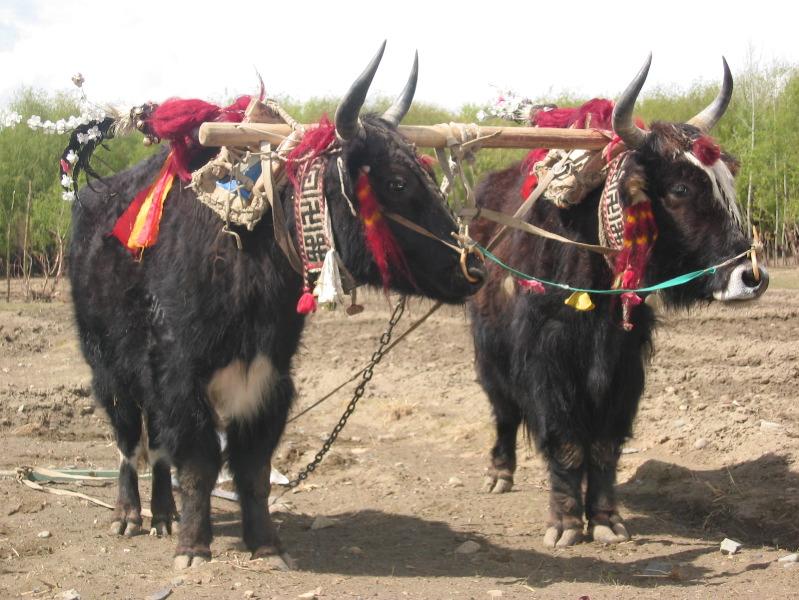Yak (Bos grunniens) - Wiki Yak
From Wikipedia, the free encyclopedia
[Photo] In Tibet, yaks are decorated and honored by the families they are part of. Buddhism encourages respect for animals. Photo by Nathan Freitas http://www.onwardtibet.org/
The yak (Bos grunniens) is a long-haired humped domestic bovine found in Tibet and throughout the Himalayan region of south central Asia, as well as in Mongolia. In Tibetan, the word yak refers only to the male of the species; a female is a dri or nak. In most languages which borrowed the word, including English, however, yak is usually used for both sexes.
Wild yaks (subspecies B. g. mutus) stand about two meters tall at the shoulder. Domestic yaks are about half that height. Both types have long shaggy hair to insulate them from the cold. Wild yaks can be either brown or black. Domesticated ones can also be white. Both males and females have horns.
Wild yaks
Wild yaks can weigh 1,000 kg (2,200 lb). They usually form groups of between 10 and 30 animals. Their habitat is treeless uplands like hills, mountains and plateaux between 3,200 m (10,500 ft) and roughly 5,400 m (18,000 ft). They eat grasses, lichens and other plants. During the warmest season these hardy animals live in areas of permanent snow and move lower down at colder times. They are insulated by dense, close, matted under-hair as well as their shaggy outer hair. Yaks secrete a special sticky substance in their sweat which helps keep their under-hair matted and acts as extra insulation. This secretion has been extracted by Nepali tribes and used in medicine. Many wild yaks are killed for food by the Tibetans; they are now an endangered species.
Domesticated yaks
Domesticated yaks are kept primarily for their milk, fiber, and meat; they are also used as beasts of burden, transporting goods across mountain passes for local farmers and traders as well as in support of climbing and trekking expeditions. Yak milk is often processed to a cheese called chhurpi in Tibetan and Nepali languages, and byaslag in Mongolia. Often the pack animals are actually crossbreeds of the yak and Bos taurus (common domestic cattle). These are known in Tibetan as dzo or dzopkyo.
Yak fiber is soft and smooth, in several colors, including shades of gray, brown, black and white. The length of yak fiber is about 1.2 inches. It is combed or shed from the yak and then dehaired. The result is a splendid downy fiber that can be spun into yarn for knitting.
Unlike cattle, yaks grunt rather than moo. Yaks can weigh over 1200 pounds and have a lifespan of 20-25 years.
More recently, sports involving domesticated yaks, such as yak skiing or yak polo, are being marketed as tourist attractions in Central Asian countries.
http://en.wikipedia.org/wiki/Yak
| The text in this page is based on the copyrighted Wikipedia article shown in above URL. It is used under the GNU Free Documentation License. You may redistribute it, verbatim or modified, providing that you comply with the terms of the GFDL. |
